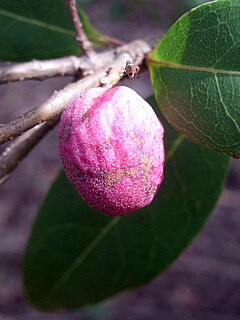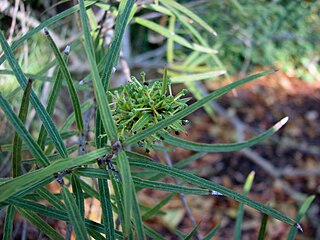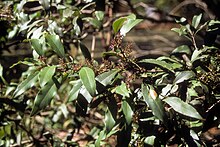
Pandorea is a genus of nine species of flowering plants in the family Bignoniaceae and is native to Australia, Malesia, New Guinea and New Caledonia. Plants in the genus Pandorea are mostly woody climbers with imparipinnate leaves arranged in opposite pairs, flowers in groups with tube-shaped flowers, and winged seeds.

Kennedia is a genus of thirteen species of flowering plants in the in the pea family Fabaceae and is endemic to Australia. Plants in this genus are prostrate or climbing perennials with trifoliate leaves and large, showy, pea-like flowers. There are species in all Australian states.

Nestegis is a genus of flowering plant in the olive family, Oleaceae. There are five currently accepted species in the genus: three species are endemic to New Zealand, while one can be found on New Zealand and Norfolk Island. Another is restricted to Hawaiʻi.

Dioscorea transversa, the pencil yam, is a vine of eastern and northern Australia.

Rhodomyrtus is a group of shrubs and trees in the family Myrtaceae described as a genus in 1841. The genus is native to southern China, the Indian Subcontinent, Southeast Asia, Melanesia, and Australia.

Notelaea venosa is a very common shrub or small tree in eastern Australia. Occurring in or adjacent to rainforest from Lakes Entrance, Victoria to Cunninghams Gap in south eastern Queensland. Common names include veined mock-olive, smooth mock-olive, large-leaved mock-olive and large mock-olive. Often seen in the bushland areas in Sydney.

Notelaea longifolia is a very common shrub or small tree in eastern Australia. Occurring in or adjacent to rainforest from Mimosa Rocks National Park to Bamaga in far north Queensland. Common names include large mock-olive or long-leaved-olive. An attractive ornamental plant.

Notelaea ligustrina, known as the privet mock olive, native olive, doral or silkwood, is a plant in the olive family, found in south eastern Australia. It is known to grow in and near rainforests south of Monga National Park in New South Wales, and into Victoria and the island state of Tasmania. The specific epithet ligustrina refers to the Privet, which it resembles.

Notelaea microcarpa is a bush or small crooked tree from the Olive Family, found in eastern Australia. Two varieties are recognised; var. microcarpa, the velvet mock olive and var. velutina known as the gorge mock olive.

Notelaea lloydii, commonly known as Lloyd's olive, is a shrub in the olive family, found in Queensland, Australia. It is listed as "vulnerable" under the Commonwealth Environment Protection and Biodiversity Conservation Act 1999.

Lithomyrtus is a genus of small trees and shrubs in the myrtle family, Myrtaceae. There are 11 species, native to the tropics of northern Australia and New Guinea:
Venosa may also refer to:

Templetonia retusa, known as cockies tongues, cocky's tongues, or coral bush is a shrub in the family Fabaceae (Leguminosae) that grows in southern and south-western Australia. It grows up to 2 metres high, with leaves 15–40 millimetres (0.6–1.6 in) long and 7–25 mm (0.3–1.0 in) wide. Its flowers are normally a rich red colour, and are 25–40 mm (1.0–1.6 in) long. The seed pods are 40–50 mm (1.6–2.0 in) long and around 10 mm (0.4 in) wide. It is found in coastal woodland and heaths over limestone from Shark Bay, Western Australia, to near Kangaroo Island, as well as inland in the Flinders Ranges of South Australia.
Large mock-olive is a common name for several plants and may refer to:
Notelaea ipsviciensis, also known as the Cooneana Olive, is a species of flowering plant in the olive family that is endemic to Australia.
Notelaea johnsonii, also known as the veinless mock olive, is a species of flowering plant in the olive family that is endemic to Australia.
Notelaea neglecta is a species of flowering plant in the olive family that is endemic to Australia.
Notelaea linearis, also known as the native olive, is a species of flowering plant in the olive family that is endemic to Australia.
Notelaea punctata, also known as the large mock-olive, is a species of flowering plant in the olive family that is native to eastern Queensland, Australia.
Notelaea pungens is a species of flowering plant in the olive family that is endemic to south-eastern Queensland, Australia.












